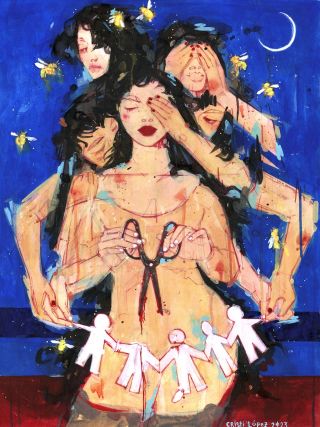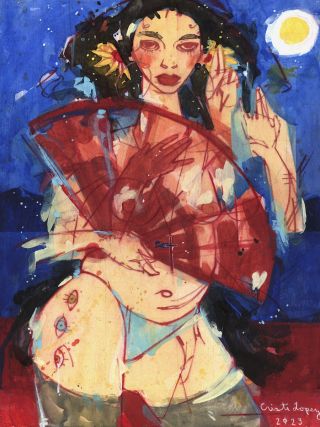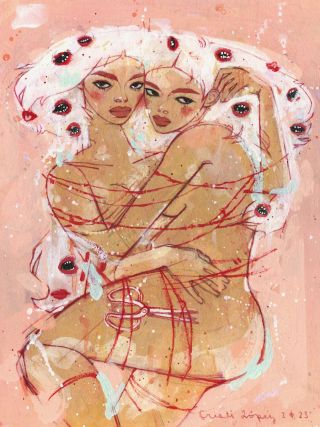OCD
There's More to OCD Than You Think: A Conversation With Cristi López
Artist Cristi López inspires people with her work and advocacy.
Posted April 4, 2023 Reviewed by Abigail Fagan
Scissors are featured prominently in artist Cristi López's paintings. She ties this back to her “OCD Origin Story”—some of Cristi’s earliest memories are that of a deep and unrelenting fear that she would accidentally kill her entire family in her sleep. Welcome to OCD.
Cristi was an avid sleepwalker from childhood through her teenage years, and the knowledge that she was capable of doing things (usually staring blankly at her parents while they slept and/or walking out the front door) ignited a fear in Cristi of her own violent potential that consumed her mind. As the dysfunctional cycle of OCD took hold of her young mind, she requested that her parents hide all of the sharp objects in the house. Obsessions of doing harm trailed her at every turn and scissors were among the most feared objects.
But just as all superheroes have an origin story, they also have a superpower. In her artwork, Cristi turns what is diabolical, Greek for what tears us apart, into something symbolic, Greek for what brings us together.
“Scissors are a recurring motif, representative of the obsessive violent thoughts that plague many sufferers of OCD. My figures do not shirk from this object and its violent potential as their fears would have them. Rather, they wield the object of their fear, often visibly cut and bleeding. In the context of my work, scissors are a symbol of reclamation."

As Allan Weinberger, owner of A Very Serious Gallery, puts it:
"There's a connection between mental health and creativity. It's a fire that can warm a house or burn it to the ground. Cristi has learned to harness this fire to create groundbreaking, spectacular paintings that bring a positive conversation to an often debilitating illness."
Stylistically, López draws inspiration from symbolist painters Klimt, Kahlo, and Redon, and Austrian expressionist Egon Schiele. The new body of work she created for Unravel is informed by the bold primary color palettes of the Dominican folk art that lives on the walls of her childhood home and in the country from which her parents emigrated.
Cristi is a first-generation American of Dominican, Spanish, and Cuban descent. Cristi notes, “Latin American culture is collectively lacking in its acknowledgement of mental illness. This lack of awareness has had ramifications in my own life and the lives of multiple family members, some of whom did not survive their battles. It took me 25 years to be diagnosed with Obsessive Compulsive Disorder after a lifetime of struggle. I aim to be visible in hopes that it will encourage others, especially those plagued by cultural stigma, to be visible as well.”

Q&A With Cristi López
Michael: Death, to me, is the root note of OCD. It's as if people with OCD have this capacity to notice the fragility of life and the possibility of death in a way that's much more intense than most. In its worst moments, it is the most harrowing part of OCD, and yet it can also imbue the world with quite a bit of meaning and dimension.
I noticed that connection to death in your work as well. You have this wonderful painting called Body Count. From the name, you'd think it'd be pretty gruesome, but instead, it's this interesting collection of women's faces being held by a central nude figure. They seem proud, strong, and vulnerable, and you can almost imagine them as multiple aspects of the main figure or the lovers she has kept. Echoing in the background of this lively picture is the pun of death itself.

Cristi: Death is the universal obsession. I’ve long been fascinated by exploring how death has been cross-culturally interpreted in art, whether that’s visual, written, or in funerary customs. The undeniability of death is essentially the only thing that someone with OCD can accept as true. It's the only absolute. What easier thing is there to obsess over than something that you know is going to happen? All of my most troubling obsessions ultimately end in death, and my most fervent subjects of research are also death-related.
Michael: Another element in your work—and in OCD—is that of repetition. In your painting Surface Tension, we see multiples of not only a woman's face but of her open mouth. Yarn surrounds her and yet she is almost in an embrace with herself while she also seems somewhat trapped. Can you speak to how your paintings speak to the seemingly futile repetitions of OCD?
Cristi: In my early twenties, a colleague pointed out to me that all of the stories I wrote and illustrated were variations on the myth of Sisyphus, the archetypal absurd hero. I found this observation interesting but had no idea just how applicable the myth of Sisyphus was to my OCD journey.
At 25, I reached what I’ve heard others call their “OCD breaking point”—my dysfunction was so acute that it led to diagnoses and (finally) proper treatment and medication. As is the case with any healing journey, the process is often more circular than linear. I often think about this passage from Camus’ essay The Myth of Sisyphus and how it embodies the struggle and beauty of existing within these seemingly unending cycles.
“I leave Sisyphus at the foot of the mountain. One always finds one's burden again. … The struggle itself toward the heights is enough to fill a man's heart. One must imagine Sisyphus happy.” ―Albert Camus

Michael: Unravel depicts a wounded female nude, against a backdrop of the Chicago skyline. Like those who suffer and soar due to OCD’s hidden sensitivity, the main figure carries power, confidence, and emotional vulnerability; she evokes a sense of duality, intimacy, and frenetic calm. My take on OCD is that it arises from a sensibility of sensitivity that is so often misunderstood and unnurtured. Talk to me about the ways in which you found ways of integrating that sensitivity and what the journey was like.
Cristi: Firstly, I appreciate your advocacy around the connection between sensitivity and OCD. When I was 20, my therapist encouraged me to try reframing my sensitivity by reading Elaine Aron’s The Highly Sensitive Person. This was the first time I saw sensitivity painted as a potentially positive, even powerful, trait. I can’t count the number of times in my life that my sensitivity has been cited as a problem, an inconvenience, and something to be remedied. The traits I possess that were reinforced and encouraged by the schooling system included perfectionism, rigidity, structure… things that made me a model student. That’s not to say that my creativity was always stifled, but my sensitivity and emotionality weren’t celebrated the way that my perfectionism was and certainly not linked to my academic success in the way my discipline was. I think that both structure and creativity are integral to a balanced life, but, aided by the all-or-nothing tendencies of OCD and cultural messaging, I overdeveloped the structured parts of me to the point where I was incapacitated.
.jpg?itok=fdQcfCzz)
Michael: You've mentioned before that the process of painting itself has some uniquely therapeutic benefits for OCD. Can you share some of those with our readers?
Cristi: My decisive lines and color application stand in contrast to the indecisive and doubting nature of the OCD mind. There is no room for incessant doubting or painstaking rendering. While I am creating portraits of my mental illness, I do so by actively combating its tendencies. In this way, the process of creation has healing potential, and is a challenge to the artist herself.
Michael: And I know you're excited about your upcoming solo show. Tell me more about how it connects to your advocacy work for OCD.
Cristi: My work aims to remind those of us living with mental illness that our experiences deserve to be acknowledged without judgment. To be portrayed is to be seen. This show with VSG and our collaboration with NAMI Chicago provides me with an unprecedentedly large platform to share this message of hope, healing, and solidarity.
Unravel: Portraits of My Obsessions opens on April 7, 2023, at A Very Serious Gallery, in Chicago IL, and will be on display until May 13, 2023.
Michael: I'd like to conclude with a piece that brings it all together for me. Self-Reassurance portrays a woman confidently looking at her reflection in a hand mirror. There's a playfulness and whimsy in the piece, and yet if you look closely, an alligator is swallowing her up.
Unperturbed, the woman sees herself clearly, and there is an artist's palette held in place by those scissors again. To me, it represents everything you are doing in service of your art and your advocacy.
Thank you so much for taking the time to be with us today to share your unique vision.
.jpg?itok=m2EhIDBy)




